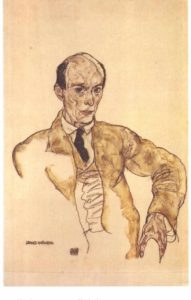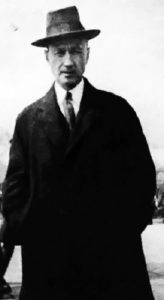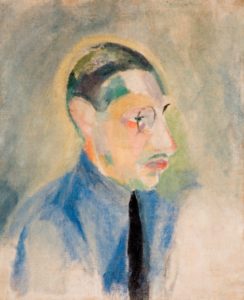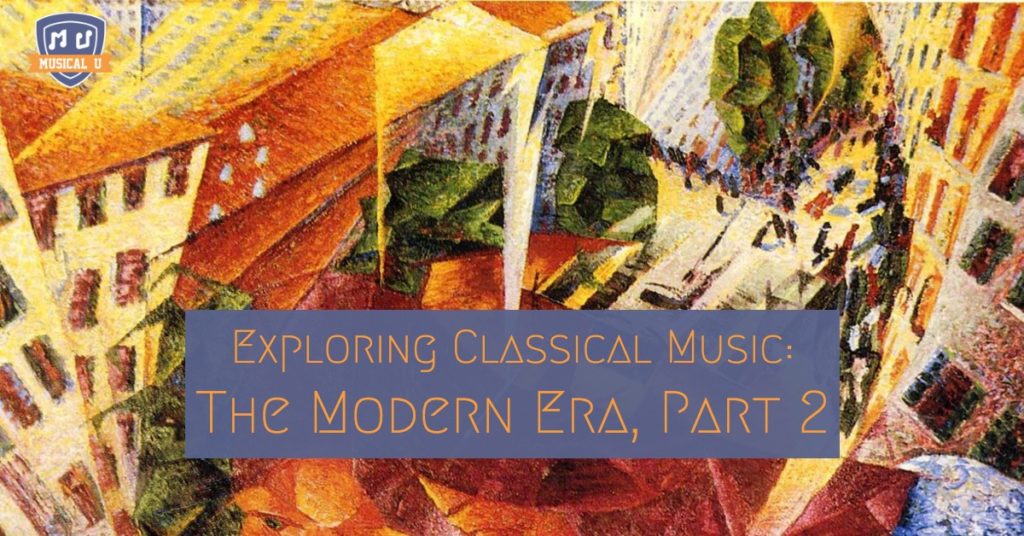The venerable Renaissance, Baroque, Classical, Romantic eras of Western classical music had their share of daring and innovative composers. But most of them kept within the bounds and traditions of tonal organization established by the early 1600s.
Not so with the restless modernist composers of the first half of the 20th century. Indeed, it sometimes seems that beyond creating new music, each composer strove to reinvent music itself.
Charles Ives reconstructed his childhood with jarring musical collage, and Igor Stravinsky bounced restlessly from one style to another, trying on just about every “ism” of the era (for more on those “isms”, click back to Exploring Classical Music: The Modern Era, Part 1).
But let’s begin with the man who attempted to obliterate the tonal system itself:
The Music of Dark Foreboding
 Arnold Schoenberg’s Erwartung (Expectation) is a 1909 monodrama for one soprano plus orchestra that lasts about 20 minutes in performance. As a German expressionist, Schoenberg (1874-1954) sought to capture sometimes uncomfortable interior emotions – which countered drastically the portrayal of outwardly superficial human responses typical of the French school’s impressionistic leanings.
Arnold Schoenberg’s Erwartung (Expectation) is a 1909 monodrama for one soprano plus orchestra that lasts about 20 minutes in performance. As a German expressionist, Schoenberg (1874-1954) sought to capture sometimes uncomfortable interior emotions – which countered drastically the portrayal of outwardly superficial human responses typical of the French school’s impressionistic leanings.
While not necessarily motivated to cut ties completely with his musical past, Schoenberg ranked innovation as his most important artistic goal: he believed forward progress was the only viable trajectory. By 1909, he had officially shunned tonal music; indeed, the system of major and minor key centers that had governed the creation and organization of melodic and harmonic materials for three centuries by now seemed superfluous.
Erawrtung proved particularly unique. “Da kommt ein Licht!” is scene 3 of the narrative, where the character wanders the forest looking for her lover, only to stumble on a dead body. Throughout, the sense of anticipation is palpable, as are nature references and the darker side of humanity – both defined targets for the German expressionist.
In this case, the character confronts the power of nature as well as to the psychological tricks played by her own mind (this was the age of Freud, after all): while waiting for her lover, she wonders if she has actually already killed him. She’s clearly operating somewhere between reality and imagination, decision and indecision, and the musical elements support those twisted frames of mind.
Schoenberg finds ways to emphasize her internal thoughts, abstracted through elements like melody, texture, and rhythm. Arguably, it’s best to not focus so much on exact timings while listening. Let the variety of sounds suffuse the ears to get the best sense of the narrative – and of the character’s panic and bewilderment.
Use of Atonality
The piece is scored for full orchestra including winds, brass, percussion, and even glockenspiel, but note how Schoenberg resorts often to a thin instrumental texture. This allows the vocal style to remain sensitive to the text – and keeps the singer from being overpowered. There is no declared key center for this piece; rather, Schoenberg deliberately avoided tonal functions.
The lack of “anchor” pitch tethering melodic lines or vertical sonorities (stacked pitches or chords), only further complements the character’s feelings of disorientation.
Sensitive to the problems of organization typical of atonal music, Schoenberg sought other means to impart logic. At the beginning, listen to the long-held sustained pitches (or pedal point) above which the singer executes a disjunct vocal melody. There is also a repetitive melodic motive, or ostinato, underlying the texture starting around [0:10]. This is a vital trick, as the repetition lends coherence even in the chaos caused by a missing key center.
Throughout, the winds (notably clarinet and oboe) flutter, their distinctive timbres helping craft the dark, dreary atmosphere. The fact that their material can’t be analyzed in terms of tonal principles also contributes to the character’s uncertainty.
The scene is through-composed, so don’t expect any large-scale repetition; after all, that kind of formal coherence wouldn’t match the character’s state of mind. Throughout, though, revel in the many countermelodies (in both winds and strings) that add depth and color to this short scene. Note, too, how the voice sort of ricochets off of instrumental lines, counteracting their lyricism with more speech-like declamations:
Collages and Collisions
Charles Ives (1874-1954), almost an exact contemporary of Schoenberg, remains one of the most enigmatic of all 20th-century American composers. Interestingly, Ives was an insurance magnate, not a professional musician. To a certain extent, then, he acted as an outsider, remote from the musical mainstream.
Ives relied on personal instinct and internal imagination, not compositional rule of law. He consistently borrowed from familiar material, like popular tunes, hymns, or anthems, and he cleverly merged these with his personal ideas into a sort of sonic collage. Specifically, Ives drew musical inspiration from his own past, admitting that potent childhood events and experiences shaped his creative content.
Invoking a Scene: Putnam’s Camp
“Putnam’s Camp” is the second movement of the orchestral suite Three Places in New England from 1917, where each of three movements portrays a particular location (note the extra-musical associations).
Here, Ives extolled a spot near Redding, Connecticut, which he visited as a child. On the historical landmark registry since the 1880s, this site marks the spot where revolutionary war hero Israel Putnam had set up camp a century earlier. As a child, Ives’ family returned there for patriotic celebrations, complete with parades and marching bands.
 Ives offered some description of “Putnam’s Camp,” indicating the music depicted the thrill of a child taking in a picnic and parade, dealing with the competing sounds of multiple village bands assembled by not-so-expert players.
Ives offered some description of “Putnam’s Camp,” indicating the music depicted the thrill of a child taking in a picnic and parade, dealing with the competing sounds of multiple village bands assembled by not-so-expert players.
The boy wanders off in hopes of seeing some real soldiers, then retires for a nap as the music appropriately fades in the distance. While resting, his mind wanders, all while patriotic tunes continue to inundate him.
A return to the opening material indicates the boy has re-joined the festivities. Based on this sequence, the piece is analyzed in a ternary (or ABA) form.
Many Musical Ideas In One Piece
Ives was never wedded to a single idea or style, so “eclecticism” nicely describes how multiple ideas accumulate to a grand overall effect in his music. “Putnam’s Camp” starts off in veritable cacophony, with striking dissonances and a kind of “disconnect” between the strings’ lyricism and brass outbursts. That gives way by [0:51] to a brass fanfare, introducing what sounds like a steady march. Since half the fun is recognizing the borrowed melodies he inserts, I won’t give them all away, but catch snippets of “Yankee Doodle” at [1:08] and enjoy how it sounds somewhat out of place in this orchestral context.
Ives initiates a quieter, dream-like sequence at [2:00], where again bits of familiar tunes sound in the flutes at [2:22], then give way to a prominent oboe solo sounding out against a fluttering ostinato. Enter the strings at [2:47], with a proud countermelody that morphs into a poignant descending line. At [3:17], Ives imparts a more regular beat, almost as if the boy is emerging from a sleepy dream state, secured by the rousing call to arms at [3:43].
Listeners are treated at [4:29] to a partial return to the opening material, but this time in competition with so many other musical strands that joyful confusion erupts – just as Ives might have remembered things going way back when.
One final note: The clip linked here features an artist’s response to “Putnam’s Camp”. This seems right up Ives’ alley in terms of getting to the heart of a participatory musical experience:
New Life for an Ancient Prayer
The choral music of Russian composer Igor Stravinsky (1882-1971) has earned its rightful place in the performing repertoire, and Stravinsky himself remains one of the most influential composers of the 20th century. Stravinsky posed an international aesthetic force, moving from Russia to France, then finally earning citizenship in the United States.
Over a long career, this innovator explored countless stylistic options, including nationalism, neo-classicism, and even atonal music. His “Mass” from 1948 counts as a neo-classical work, and the “Credo” (Creed) movement is a manageable sub-section toward understanding this part of his output.
The “neo” (or “new”) of this trend does not necessarily equate to a composer recycling the past. Instead, Stravinsky reevaluated and reinterpreted past genres (the Mass setting), as well as forms and other stylistic options via his very modern sensibilities. In other words, this won’t sound like “old” music to your ears!
A concern for Stravinsky was respect for these prayerful words, so he set the “Credo” text syllabically (one syllable per note), almost mimicking monophonic chant. The declamatory delivery renders the words clearly, resulting in the clarity that helps preserve the purpose and function behind Christian practitioners’ age-old liturgical traditions.
 This is in itself neo-classical, since church fathers from centuries past decreed that the essence of the Credo prayer, even when set to music, must be preserved. In support of the vocal lines, Stravinsky reverted to economical orchestral accompaniment in opposition to the Romantic era’s idea that bigger is always better.
This is in itself neo-classical, since church fathers from centuries past decreed that the essence of the Credo prayer, even when set to music, must be preserved. In support of the vocal lines, Stravinsky reverted to economical orchestral accompaniment in opposition to the Romantic era’s idea that bigger is always better.
Stravinsky treated the prayer in sections, but still there is near-constant motion, with only rare cadences in the vocal or instrumental parts. The constancy of this march-like setting seems to target the idea of momentum and energy – and celebrates the staying power of a seemingly ageless message.
The movement starts with solo incipit, or first line of the prayer: “Credo in unum Deum” at [0:00-0:08]. Then comes a choral and instrumental response at [0:10]. A dialogue is initiated and continues to frame the movement throughout. Strong dissonance erupts between instruments and choral parts: their independent lines weaving a dense polyphony as the men bottom out into their low range.
At [1:00] comes the phrase “Deum de Deo, Lumen de lumine” (“God from God, Light from Light”), and Stravinsky resorts to short, staccato utterances to create a contrast to the smoother, more legato phrasing so far.
By [1:58], the words come via a more relaxed delivery; there is even a sweet and comforting consonant chord right at [2:04] on “et incarnatus est.” This sets up an instrumental interlude for [2:06-2:13]. The lilting, rocking motion in the lower winds adds momentum at [2:13], which builds to the all-important line “Et resurrexit” (He rose) that hovers right around the corner at [2:33].
Of course, Stravinsky is just one of many composers who set the Catholic mass texts to music over the centuries, and it’s telling to study how each sets this particular segment. His choice to layer in ample drama via a higher range for the women and a louder dynamic only adds to the release and joy of that particular sentiment.
From [4:10-4:30], Stravinsky challenges listeners through dynamic shifts—first quiet, then loud, then quiet again, and so on. The back and forth builds to an important climax at what was indeed a critical turning point in the liturgical service itself. Finally at [4:58], the instruments drop out for the “Amen” sequence, which is reflective, abstract, and austere:
Thus, with an ancient “Amen”, we end today’s exploration of the most disruptive era in Western classical music history! And more astonishing musical treasures await the daring listener – Berg’s “Wozzeck”, Gershwin’s “Rhapsody in Blue”, Copland’s “Enigma Variations” are just a few of the widely varying musical expressions of this heady time. So while you’re waiting for our next Exploring Classical Music installment, wrap your ears around the modernist musical revolution of the 20th century.







